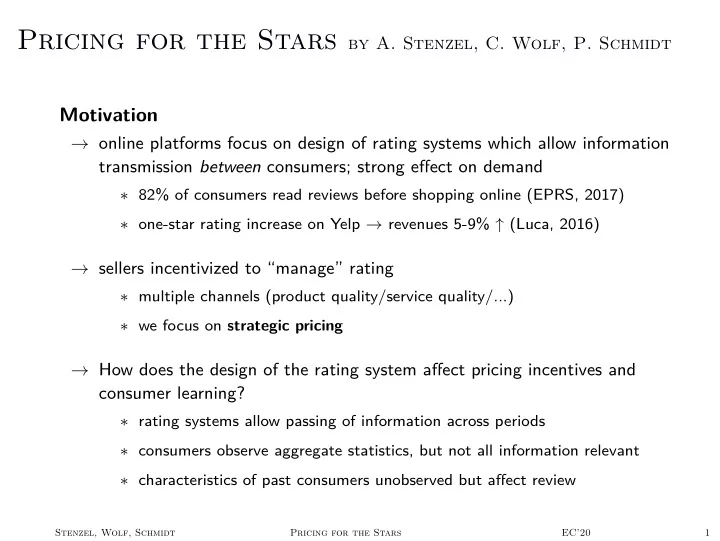

Pricing for the Stars by A. Stenzel, C. Wolf, P. Schmidt Motivation → online platforms focus on design of rating systems which allow information transmission between consumers; strong effect on demand ∗ 82% of consumers read reviews before shopping online (EPRS, 2017) ∗ one-star rating increase on Yelp → revenues 5-9% ↑ (Luca, 2016) → sellers incentivized to “manage” rating ∗ multiple channels (product quality/service quality/...) ∗ we focus on strategic pricing → How does the design of the rating system affect pricing incentives and consumer learning? ∗ rating systems allow passing of information across periods ∗ consumers observe aggregate statistics, but not all information relevant ∗ characteristics of past consumers unobserved but affect review Stenzel, Wolf, Schmidt Pricing for the Stars EC’20 1
Contribution Tractable framework of dynamic pricing in presence of rating systems → long-lived firm sells good of fixed quality to short-lived consumers → consumer inference based on heuristic (“quasi-stationarity”) → interaction of pricing incentives and information transmission Capture empirically documented relationships b/w prices & reviews → price ↑ = ⇒ review ↓ due to direct price effect → price ↑ = ⇒ review ↑ due to selection effect → strength of direct price effect product-specific ∗ dominates for standardized products (USB sticks, Cabral and Li (2015)) ∗ selection effect dominates otherwise (e-books, Zegners (2019)) ∗ in line with own analysis of video games, casual vs. non-casual
Model Ingredients → long-lived firm sells good of fixed quality to short-lived consumers ∗ t ∈ { 1 , 2 , . . . , T } , T ≤ ∞ → purchasing consumers leave review which depends on ∗ quality ( + ) ∗ idiosyncratic taste ( + ) ∗ prices weighted by parameter ( – ) → quality inference ∗ based on current aggregate rating & current price ∗ heuristic: assume past consumers faced same price and rating (quasi-stationary) → updated rating is weighted average of previous rating & average review ∗ weight parameter measures sensitivity to incoming reviews
Results Long-run properties of learning → consumers hold correct beliefs about quality in long-run (despite heuristic) → not affected by details of rating systems ( sensitivity to new reviews) Long-run properties of prices & consumer surplus → sensitivity affects long run prices & consumer surplus ∗ strong price effect: sensitivity ↑ = ⇒ price ↓ , CS ↑ ∗ weak price effect: sensitivity ↑ = ⇒ price ↑ , CS ↓ → higher sensitivity increases dynamic pricing incentives → strength of price effect determines direction of dynamic pricing incentives → policy changes by many platforms may have reduced consumer surplus ∗ firms always benefit as it makes reaching “target rating” less costly
Recommend
More recommend